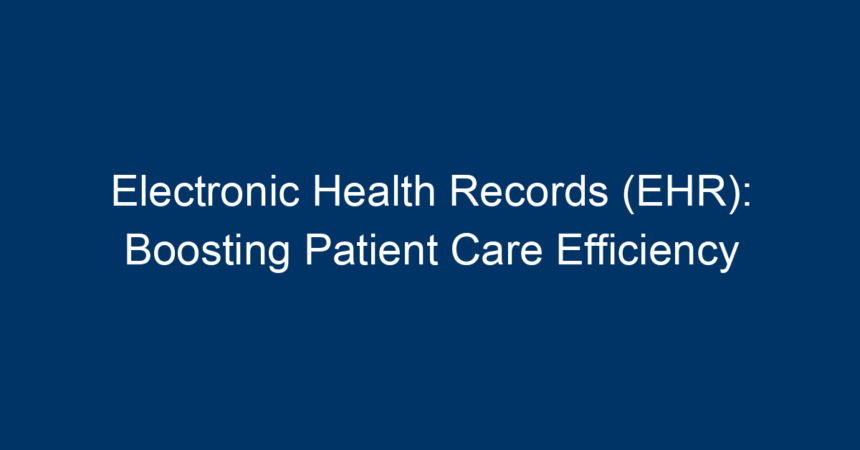Introduction
In today’s fast-paced healthcare environment, efficiency is paramount. The integration of technology into patient care has brought forth transformative tools that not only improve workflows but also enhance patient outcomes. One such pivotal advancement is the adoption of Electronic Health Records (EHR). EHR systems have revolutionized the way healthcare providers document, manage, and share patient information. This article delves into how electronic health records (EHR) are boosting patient care efficiency, exploring the numerous benefits they offer, and providing actionable insights for healthcare organizations looking to optimize their EHR systems.
What Are Electronic Health Records (EHR)?
Electronic Health Records (EHR) refer to digital versions of patients’ paper charts. They contain comprehensive medical histories, treatments, medications, lab results, and other vital information. Unlike traditional paper records, EHRs are designed to be shared across different healthcare settings, ensuring that patient information is readily accessible to authorized users. This capability is essential for improving communication among healthcare providers and ultimately enhances the quality of patient care.
The Benefits of EHR in Patient Care Efficiency
1. Improved Accessibility and Coordination of Care
One of the most significant benefits of EHR is the improved accessibility of patient information. Clinicians can access a patient’s medical history, allergies, and medications instantly, enabling informed decision-making. This accessibility is crucial in emergencies, where time is of the essence.
Moreover, EHR systems facilitate better coordination among different healthcare providers. Whether it’s a primary care physician, a specialist, or a nurse, everyone involved in a patient’s care has access to the same up-to-date information. This collaborative approach minimizes the chances of medical errors and enhances the overall quality of care.
2. Enhanced Patient Engagement
EHRs provide avenues for increased patient engagement through patient portals. These portals allow patients to review their health information, lab results, and progress notes. By empowering patients to participate in their care, healthcare providers can foster better communication and adherence to treatment plans.
When patients are more involved in their healthcare, they are more likely to understand their conditions and participate in shared decision-making with their providers. This level of engagement simplifies follow-ups and can lead to improved health outcomes.
3. Streamlined Workflow and Administrative Efficiency
EHR systems significantly streamline operational workflows within healthcare facilities. Automated processes, such as prescription ordering and appointment scheduling, reduce the administrative burden on staff. This frees up time for healthcare providers to focus more on patient interactions rather than paperwork.
Additionally, EHRs facilitate streamlined billing processes. By minimizing errors and redundancies commonly found in manual billing, these systems enhance revenue cycle management and overall financial efficiency in healthcare settings.
4. Data-Driven Insights for Better Outcomes
EHR systems are powerful tools for collecting vast amounts of health data, which can be analyzed to uncover trends and insights. Healthcare providers can use this data to track health outcomes, monitor population health, and implement preventive measures.
For instance, by analyzing EHR data, providers can identify at-risk populations for certain diseases and focus on preventive care initiatives. This proactive approach not only improves patient outcomes but also significantly reduces healthcare costs by preventing disease progression.
The Challenges of Implementing EHR
While the benefits of electronic health records (EHR) are undeniable, several challenges come with implementation and optimization:
1. High Initial Costs
Implementing EHR systems can be costly due to the need for software purchases, staff training, and system maintenance. Healthcare organizations must weigh these initial investments against the long-term benefits of improved efficiency and patient care.
2. Resistance to Change
Healthcare staff may resist adopting new technology due to unfamiliarity or fear of disrupting existing workflows. Effective training and communication about the benefits of EHR are crucial for encouraging staff buy-in.
3. Interoperability Issues
EHR systems often come from various vendors, leading to challenges in data sharing and interoperability. Ensuring that different systems can communicate and share information seamlessly is essential for maximizing the benefits of EHR.
Best Practices for Boosting EHR Efficiency
To fully leverage electronic health records (EHR) and boost patient care efficiency, healthcare organizations should consider the following best practices:
1. Invest in Comprehensive Training
Training is pivotal to the successful implementation of EHR systems. Provide thorough training for all staff members, focusing on system features, practical usage, and best practices. A well-trained staff is more likely to embrace the technology and utilize it effectively.
2. Promote User-Friendly Interfaces
Ensure that the EHR system has an intuitive design that simplifies usability. A user-friendly interface minimizes the learning curve and enhances the overall user experience, making it easier for healthcare providers to document information accurately and quickly.
3. Foster Interoperability
Choose EHR vendors that prioritize interoperability. This ensures that your system can easily share data with other healthcare providers, allowing for coordinated care. Integration with other health technologies, such as telehealth platforms, can further enhance the patient experience.
4. Regularly Update and Optimize the System
Technology is ever-evolving. Regularly review and update your EHR system to incorporate new features and functionalities. Gathering user feedback can help identify areas for improvement and ensure that the system meets the needs of healthcare providers and patients alike.
Conclusion
Electronic health records (EHR) have become indispensable tools in modern healthcare, enabling improved patient care efficiency through enhanced accessibility, streamlined workflows, and data-driven insights. While challenges such as initial implementation costs and resistance to change may arise, the long-term benefits far outweigh them. By adopting best practices in EHR implementation and continuously optimizing the system, healthcare organizations can pave the way for a more efficient, patient-centered future.
Actionable Insights
-
Conduct a needs assessment to identify the specific functionalities your healthcare facility requires from an EHR system.
-
Invest in training and support to ensure all staff members are comfortable using the EHR system.
- Engage with healthcare teams continuously to gather feedback and implement improvements based on their experiences.
By embracing electronic health records (EHR) thoughtfully and strategically, healthcare organizations can truly enhance patient care efficiency and contribute to better health outcomes for all.




